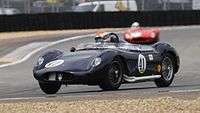Maserati 200S

| Maserati 200S | |
|---|---|
|
| |
| Overview | |
| Manufacturer | Maserati |
| Body and chassis | |
| Body style | no-door, two-seater |
| Layout | FR layout |
Maserati 200S were twenty-eight racing cars made by Maserati of Italy, to take over for the aging Maserati A6 GCS racing variants.
The Tipo 52 development started in 1952, led by Giulio Alfieri. The car had a 1994.3 cc inline-four cylinder light-alloy engine, dual OHV per cylinder and DOHC camshafts, double Weber 50DCO3 (first few cars only) or 45DCO3 carburetors. It output 190 PS (140 kW; 187 hp) at 7500 rpm. Many chassis components were identical to the Maserati 150S, except the rigid rear axle inherited from the Maserati A6.
Maserati made the first three chassis internally, but outsourced a tubular chassis to Gilco. The first five aluminum bodies were, as for the Maserati 150S, by Celestino Fiandri, and the 23 final by Medardo Fantuzzi.
No wins were seen in its first year of 1955, first by Franco Bordoni at the 1955 San Marino Grand Prix, followed by Giovanni Bracco and Bordoni at the 1955 Targa Florio. Driver Benoît Nicolas Musy died in a 200S at 'Autodrome de Montlhéry, France (1956). In 1957 the name was changed to Maserati 200SI, Sport Internazionale, to signify its conformance to international sports car racing rules. In 1958 the engine was made bigger (2.5 litres) and the car was named as 250S. The car scored a resounding victory with Stirling Moss at the wheel during the 1956 Trofeo Supercortemaggiore. He beat four Ferrari 500TRs and described the car as “very quick on twisty circuits” and “handled really nicely”.
External links
- maserati-alfieri.co.uk on the 200S
Literature
- Karl Ludvigsen, Maserati 200S/200SI